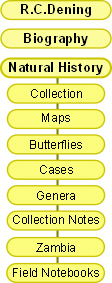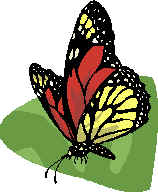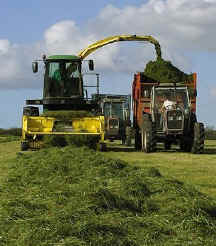 |
The Importance of
Habitats |
The blame for the extinction of species is often laid at the door of
collectors (or hunters). I believe that in most cases this is just a convenient cop out.
Given the right habitat conditions and enough food, most species are incredibly resilient.
Nature works on massive overproduction of young. Far more than can ever survive (given
that there are always limited supplies of food and other resources) are routinely
produced. This means that when adult individuals of a species die, they leave a gap
quickly filled by a juvenile which would otherwise have died in the competitive rat race
of life.
 |
To illustrate this point, a single female butterfly may
lay up to 1,000 eggs in her short life span. Only 0.2% of those eggs needs to survive in
order to maintain the butterfly population at its existing level. If 99% of all those eggs which she lays (or the successive life cycle stages)
succumb to the depredations of predators, parasites, collectors, inclement conditions,
lack of food and disease, then the butterfly population would still quadruple. This also
assumes that a male butterfly is only fertilising one female. In reality, he probably
fertilises several, which means that the population’s rate of increase based on these
figures is even higher. |
However, there is an important caveat
here - quick replacement is only possible if the habitat conditions remain suitable and
its area does not diminish. Even such apparently insignificant changes as the height of
the grass, the amount of shading or a slight rise or fall in the average temperature may
make all the difference to the survival or extinction of a population.
| A population is a collection of individuals belonging to one species,
living in a particular area. A single species is therefore usually made up of a number of
populations of individuals living in different locations. Local populations of a species may become
extinct in a particular area without affecting the viability of the whole species. Those
species which are very localised (endemic to a particular area) or where there are very
few populations left, are most at risk of extinction through habitat loss or environmental
change. |
   
|
Human Population
Pressure |
| The
extinction of species is far more attributable to the loss of their natural habitats than
to the activities of collectors. As our human populations continue to increase at an
exponential rate, more and more natural areas are converted to urban sprawls, industrial
complexes and agricultural uses in order to feed, clothe and house us all in the style we
like to be accustomed to. As a result, the area of natural habitats is shrinking at an
alarming rate. It is this loss of natural habitat which is the real culprit in the
extinction equation, with pesticides and pollution adding to the toll. |
 |
While we have very laudable
targets for restoring natural habitats for wildlife in the UK, this restoration comes at
the expense of losing areas once given over to intensive agriculture and forestry. Now, our population is not declining. It is increasing at the rate of a small
city a year. All those people need feeding and they need resources such as paper and
timber. |
|
Collectors as Species
Exterminators? |
I start
this section by stressing that I am limiting my comments to insect collecting, which is
the only area where I feel I have enough experience to venture an opinion. I would also
make the point that we have been doing our level best to exterminate various pest species
for centuries (and perhaps millennia) without having any appreciable effect and in some
cases almost losing the battle altogether (witness the success of rats). There also seems
to be something of a double standard operating here in that we would quite cheerfully
exterminate the pestilential clothes moth, but get upset at the loss of a beautiful
butterfly!
In Victorian times, woods were still regularly coppiced
for much needed timber products, while intensive agriculture, pesticides and large-scale
hedge removal were not yet common practice in the countryside. The extent and quality of
available habitats was such that butterfly numbers were high and the populations could
sustain really extensive collecting efforts. One collector in the 1820’s, recorded
that in the space of half an hour, he had captured over 200 specimens of White-letter
Hairstreak butterflies without moving from the spot (1). It is hard to imagine the dancing
parade of butterflies which must have existed at that time, to make the collecting of so
many individuals possible without any appreciable searching or long drawn out effort.
There have been no collectors in this league for a
considerable period of time now (in insect generations at least) but there are still
comparatively few butterflies. If collecting had been solely to blame, in its (relative)
absence, the numbers would have bounced back long ago.
Approximately a dozen species of butterflies and moths
have become extinct in Britain over the last 150 years, with habitat loss as the primary
cause. The Large Copper butterfly and several species of moths became extinct because the
advent of steam pumps meant that the Fens could be drained, thereby changing the habitat
beyond all recognition. Collecting may have been the last straw for one or two already
stressed, isolated populations of the Large Blue butterfly, possibly causing local
extinctions. However, the Large Blue also became extinct in areas where there was no
collecting. The real culprit in this extinction was changes in grazing practice. This
meant that the grass became too long for the survival of the ant species on which the
caterpillars’ survival in turn depended |
I am not
advocating a return to the days of indiscriminate collecting. I am merely pointing out
that the individuals of a species taken by collectors are in most cases readily (and
quickly) replaced. In addition, most adult insects have a relatively short life span
anyway. In the case of butterflies and moths, this may be as little as a few days. Within
a seasonal time frame, there is also a staggered turn over of adults, as new ones emerge
from their pupal or nymphal stages over an extended period. A collector is therefore only
ever likely to see a fraction of the total population at any one time.
We can in many cases learn much about the
natural history of species by observation alone. However, in the areas of taxonomy,
geographical distribution, genetics and evolutionary processes, specimen collecting is
often the only way of obtaining valuable and verifiable scientific data. Greater
understanding of the life and living processes going on around us, may in the end enable
us to ameliorate some of the damage caused by ever increasing demand and competition for
space and resources from human populations
Personally, I think the real danger lies not in
collecting, but in the current ideology which preaches that the environment is so fragile
that we need to put it on a pedestal and say ‘look, but don’t touch’. We
are already alienated from the realities of life to an alarming degree. The natural world
seems increasingly to be viewed as a kind of animated museum display, locked behind the
glass walls of politically correct rules and regulations which address the wrong issues
and ignore the real problems.
I owe my love of natural history to my father and the
things that he consistently showed me first hand as I grew up. Most of all, he showed me
that the natural world is real. It is robust and it changes constantly, with or without
us!
. |
| 150 years ago the world population was around 1.2 billion. It is now
over 6.5 billion (more than 5 times higher) despite massive mortality rates due to Stalin
and Hitler's efforts, two world wars, various world wide epidemics, local wars and Third
World starvation.
World Population Figures |
| (1) The Aurelian Legacy: British Butterflies and their Collecters (2000)
by The Hon Miriam Rothschild, Michael A. Salmon, Peter Marren, and Basil Harley.
This is a wonderful book with a wealth of interest, which I have
used as a source for some of the information in this article. I highly recommend it. |
|

